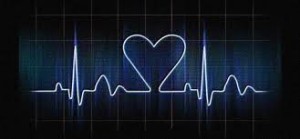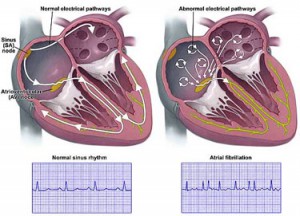In many classic songs, a lover’s heart is said to “skip a beat” when seeing or even thinking about his or her beloved. While the imagery is romantic, skipping a heartbeat is no lighthearted matter. An irregular heartbeat – whether abnormally fast or slow, or lacking a normal, steady rhythm – may be the sign of more serious heath issues. Such a heartbeat is called an arrhythmia.
Arrhythmia and Fibrillation
There are a number of types of arrhythmias, and most are no cause for concern. However, a serious arrhythmia may disrupt the heart’s ability to pump blood, which carries oxygen to the body. Lack of oxygen can damage organs such as the brain and lungs and, if prolonged, can be fatal. We will look at atrial fibrillation which is the most common arrhythmia in humans. However, before we turn to the specifics of this arrhythmia, let’s take a quick look at how the heart’s electrical system works to regulate heartbeat.
Anatomy of a Heartbeat
The heart is divided into four main cavities, or chambers. The two upper chambers are called the atria, and the two lower chambers are the ventricles. The right atrium contains cells called the sinoatrial (or SA) node that generate an electrical impulse at regular intervals to start each new heartbeat. The electrical signal causes the atria to contract, pumping blood into the ventricles. The signal then continues down the heart, between the atria and ventricles, and finally to the ventricles themselves. They, too, contract in response to the electrical signal, pumping blood to the body. This cycle occurs continuously, about every 60-100 times a minute in the average adult.
Atrial Fibrillation
Atrial fibrillation occurs when the electrical impulses that control the heartbeat originate somewhere other than in the SA node. They may originate from different parts of the atria and also from pulmonary veins, which bring back the oxygenated blood from the lungs to the heart. Instead of being steady and regular, these electrical impulses travel in a chaotic, rapid fashion that prevents the atria from contracting normally. Rather than contracting, the atria quiver – or fibrillate – and are unable to pump blood to the ventricles.
Atrial fibrillation itself usually isn’t a life-threatening condition, but it can lead to other health issues that are of much greater concern. For example, it increases an individual’s chances of developing blood clots, which can cause strokes if they travel to the brain. For this reason, people who suffer from atrial fibrillation are routinely prescribed blood-thinning medication. Heart failure is another possible complication of atrial fibrillation. This occurs when the overly rapid heartbeat produced by atrial fibrillation makes it difficult for the heart to pump enough blood to satisfy the body’s need for oxygen.
Treatment of Atrial Fibrillation
There are several treatments for atrial fibrillation. Some treatment strategies aim to restore your heartbeat to a normal and regular rhythm. Many of these treatments involve the use of special procedures designed to allow the heart to reestablish its normal rhythm, or to assist a heart that is incapable beating normally on its own. Electrical or pharmacological cardioversion , for example, is a common way to restore normal heart rhythm in individuals suffering from atrial fibrillation. Other procedures such as ablations, aim to control atrial fibrillation by destroying cells causing this abnormal rhythm.
If you suffer from an arrhythmia, you should consult with an electrophsyiologist to determine the nature of the condition. Obtaining the fullest possible picture of all aspects of your heart’s functioning is essential to determine whether you have a condition that requires closer attention. If treatment is recommended, having knowledge of a wider range of options gives your medical team the tools to find the approach best suited for you.





